Page 188 of 464
188
2-1. Driving procedures
Manual Transmission
: If equipped
Shifting the shift lever
Fully depress the clutch pedal before operating the shift lever, and
then release it slowly.
Shifting the shift lever to R
Shift the shift lever to R while
lifting up the ring section.
Page 199 of 464
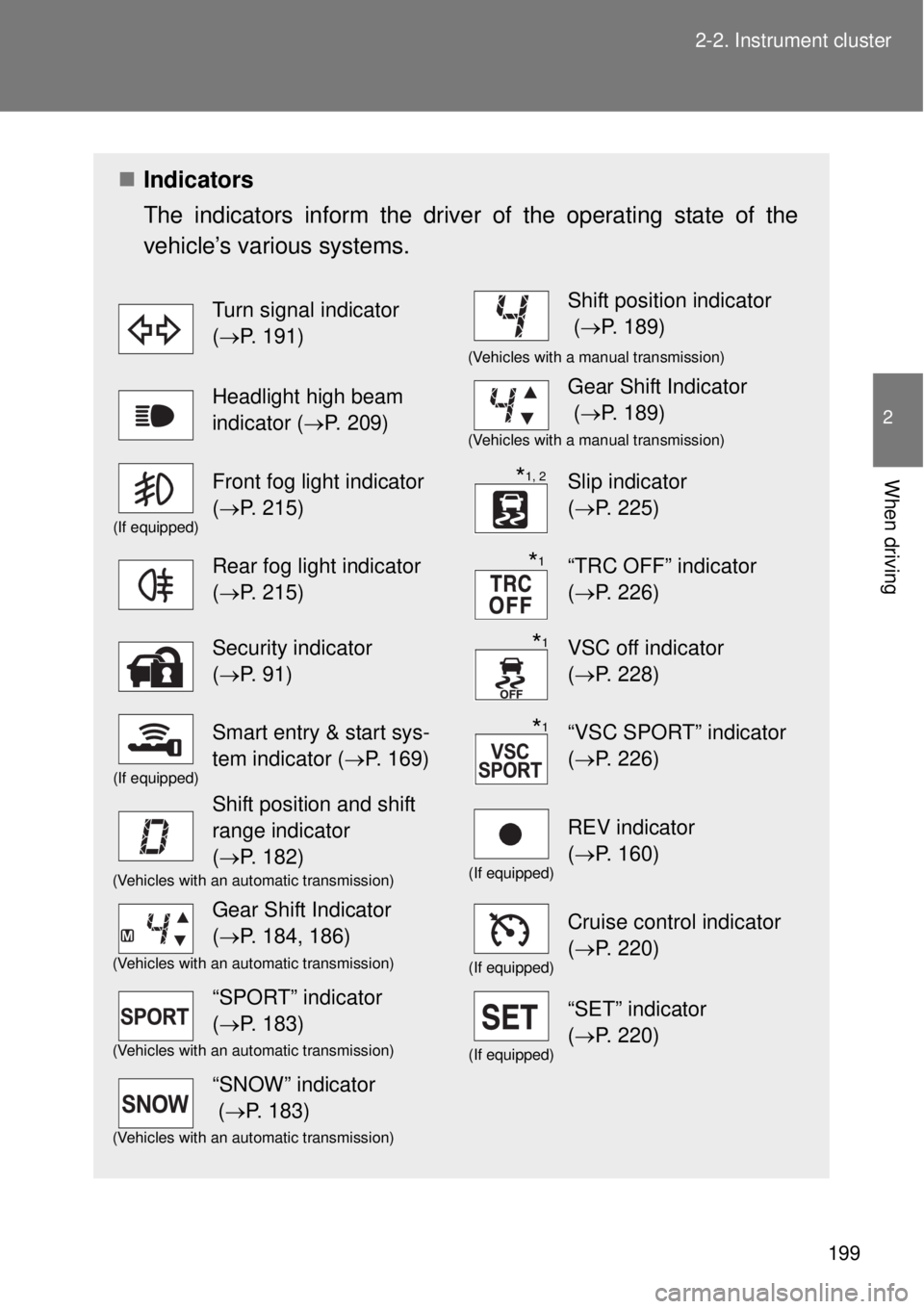
199 2-2. Instrument cluster
2
When driving
Indicators
The indicators inform the driver of the operating state of the
vehicle’s various systems.
Turn signal indicator
(P. 191)Shift position indicator
(P. 189)
(Vehicles with a manual transmission)
Headlight high beam
indicator (P. 209)Gear Shift Indicator
(P. 189)
(Vehicles with a manual transmission)
(If equipped)
Front fog light indicator
(P. 215)Slip indicator
(P. 225)
Rear fog light indicator
(P. 215)“TRC OFF” indicator
(P. 226)
Security indicator
(P. 91)VSC off indicator
(P. 228)
(If equipped)
Smart entry & start sys-
tem indicator (P. 169)“VSC SPORT” indicator
(P. 226)
Shift position and shift
range indicator
(P. 182)
(If equipped)
REV indicator
(P. 160)
(Vehicles with an automatic transmission)
Gear Shift Indicator
(P. 184, 186)
(If equipped)
Cruise control indicator
(P. 220)
(Vehicles with an automatic transmission)
“SPORT” indicator
(P. 183)
(If equipped)
“SET” indicator
(P. 220)
(Vehicles with an automatic transmission)
“SNOW” indicator
(P. 183)
(Vehicles with an automatic transmission)
*1, 2
*1
*1
*1
Page 211 of 464
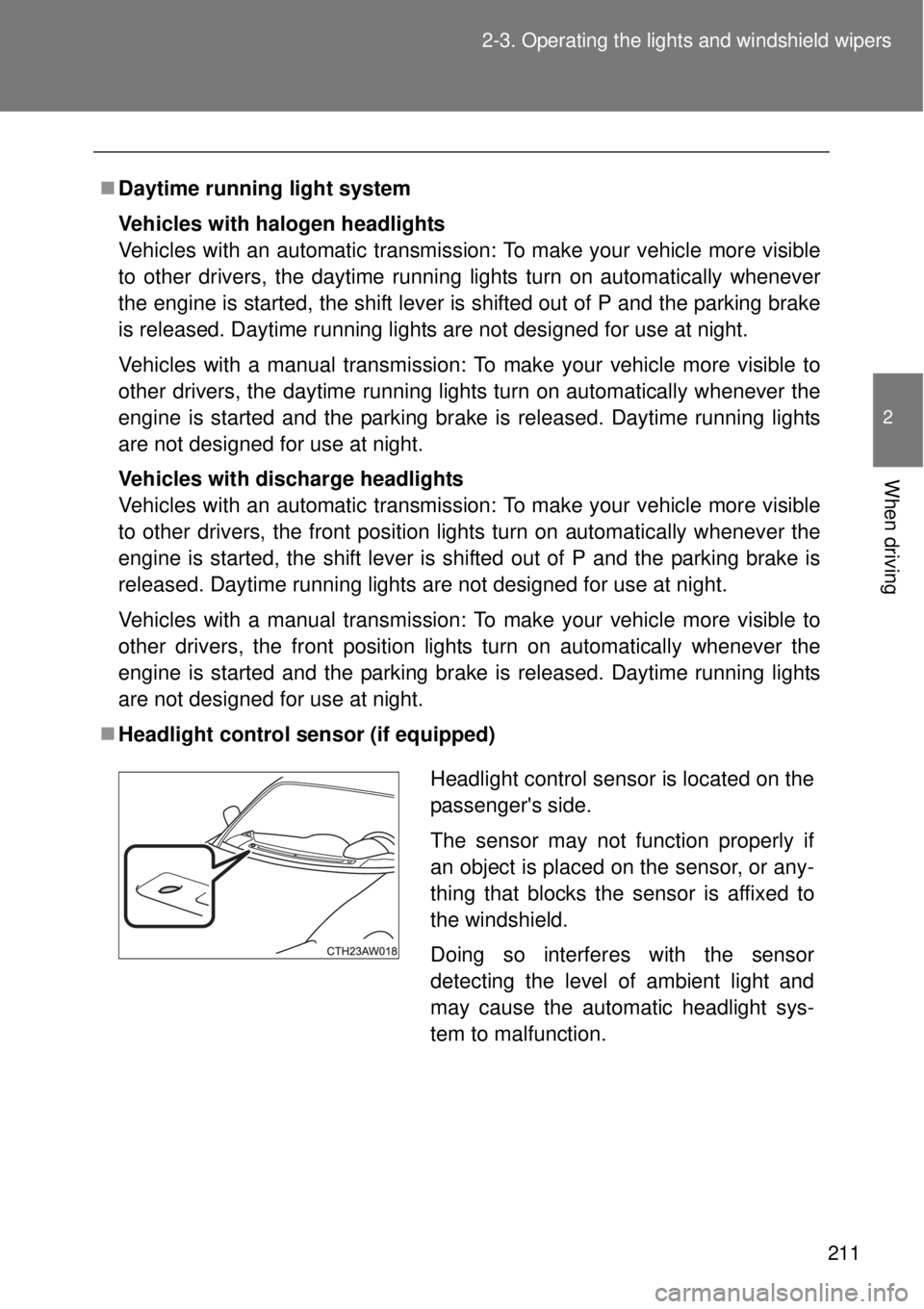
211 2-3. Operating the lights and windshield wipers
2
When driving
Daytime running light system
Vehicles with halogen headlights
Vehicles with an automatic transmission: To make your vehicle more visible
to other drivers, the daytime running lights turn on automatically whenever
the engine is started, the shift lever is shifted out of P and the parking brake
is released. Daytime running lights are not designed for use at night.
Vehicles with a manual transmission: To make your vehicle more visible to
other drivers, the daytime running lights turn on automatically whenever the
engine is started and the parking brake is released. Daytime running lights
are not designed for use at night.
Vehicles with discharge headlights
Vehicles with an automatic transmission: To make your vehicle more visible
to other drivers, the front position lights turn on automatically whenever the
engine is started, the shift lever is shifted out of P and the parking brake is
released. Daytime running lights are not designed for use at night.
Vehicles with a manual transmission: To make your vehicle more visible to
other drivers, the front position lights turn on automatically whenever the
engine is started and the parking brake is released. Daytime running lights
are not designed for use at night.
Headlight control sensor (if equipped)
Headlight control sensor is located on the
passenger's side.
The sensor may not function properly if
an object is placed on the sensor, or any-
thing that blocks the sensor is affixed to
the windshield.
Doing so interferes with the sensor
detecting the level of ambient light and
may cause the automatic headlight sys-
tem to malfunction.
Page 222 of 464
222 2-4. Using other driving systems
Cruise control can be set when
Vehicles with an automatic transmission
The shift lever is in D or M and the vehicle is in the 2
nd gear or higher.
Vehicle speed is above approximately 40 km/h (25 mph).
Vehicles with a manual transmission
The vehicle is in the 2
nd gear or higher.
Vehicle speed is above approximately 40 km/h (25 mph).
Canceling and resuming the constant speed control
Pulling the lever toward you
cancels the constant speed
control.
The speed setting is also can-
celed when the brakes are
applied or the clutch pedal
(manual transmission only) is
depressed.
Pushing the lever up
resumes the constant
speed control.
Resuming is available when
the vehicle speed is more than
approximately 32 km/h (20
mph).
Page 234 of 464
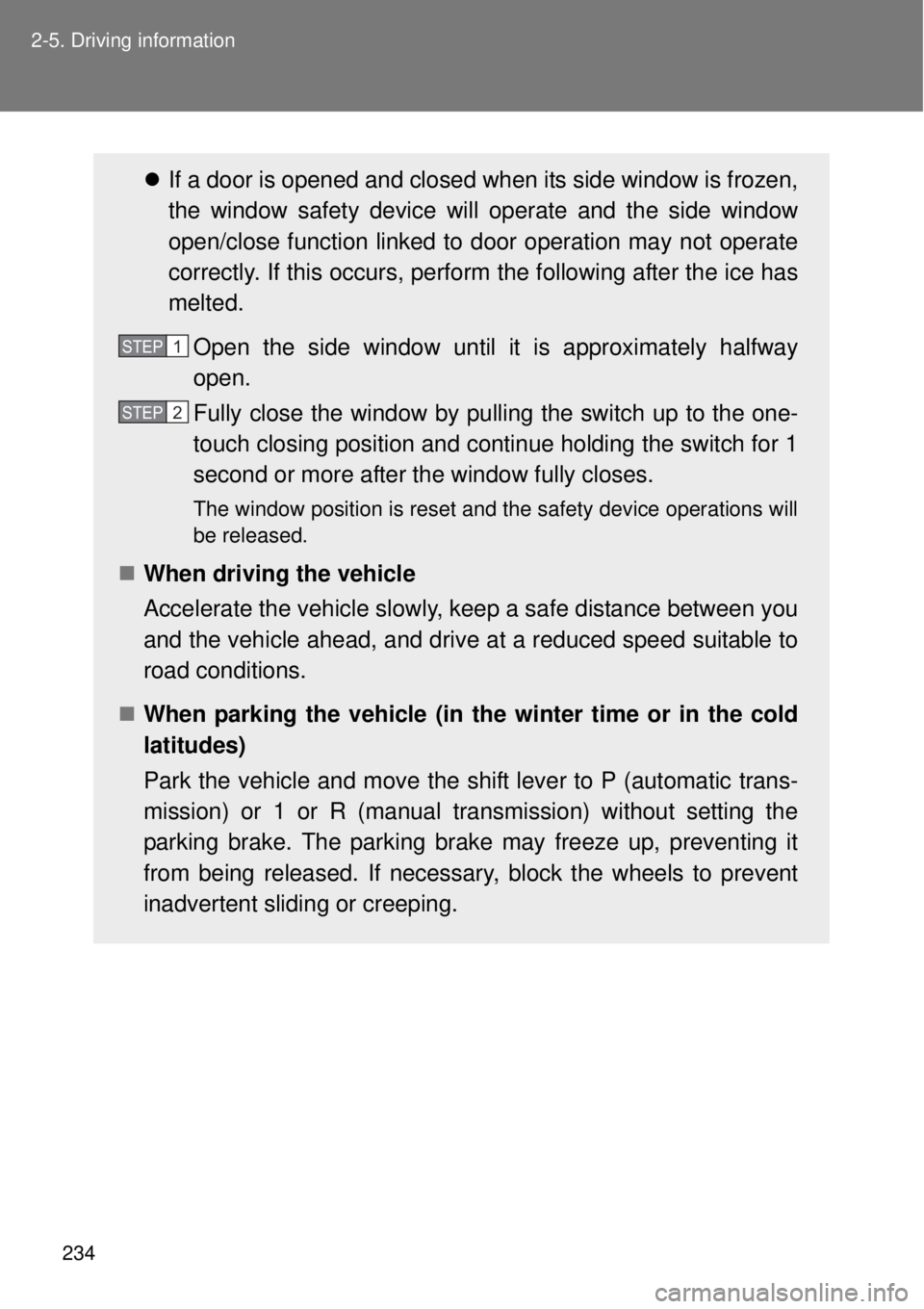
234 2-5. Driving information
If a door is opened and closed when its side window is frozen,
the window safety device will operate and the side window
open/close function linked to door operation may not operate
correctly. If this occurs, perform the following after the ice has
melted.
Open the side window until it is approximately halfway
open.
Fully close the window by pulling the switch up to the one-
touch closing position and continue holding the switch for 1
second or more after the window fully closes.
The window position is reset and the safety device operations will
be released.
When driving the vehicle
Accelerate the vehicle slowly, keep a safe distance between you
and the vehicle ahead, and drive at a reduced speed suitable to
road conditions.
When parking the vehicle (in the winter time or in the cold
latitudes)
Park the vehicle and move the shift lever to P (automatic trans-
mission) or 1 or R (manual transmission) without setting the
parking brake. The parking brake may freeze up, preventing it
from being released. If necessary, block the wheels to prevent
inadvertent sliding or creeping.
STEP 1
STEP 2
Page 276 of 464
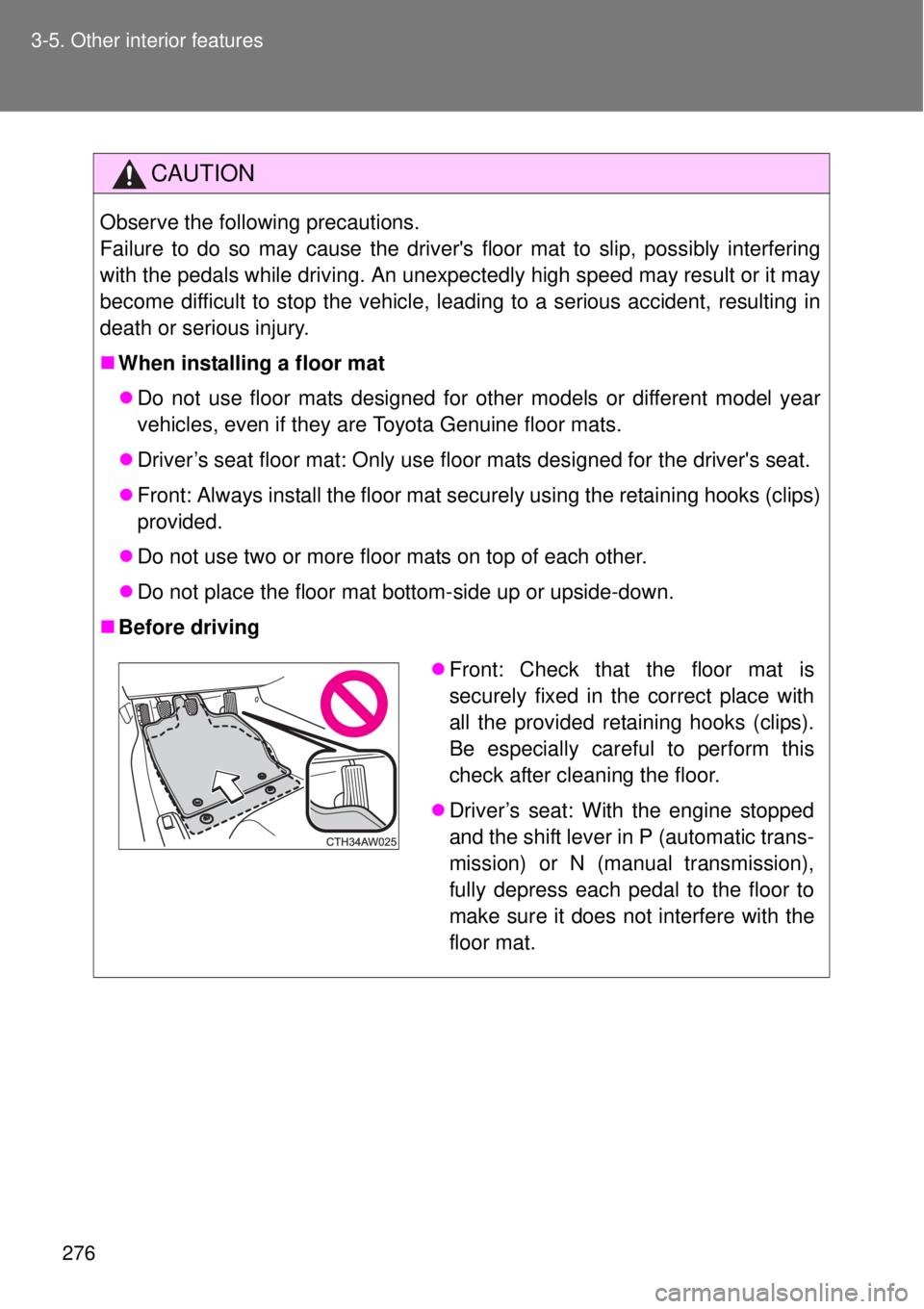
276 3-5. Other interior features
CAUTION
Observe the following precautions.
Failure to do so may cause the driver's floor mat to slip, possibly interfering
with the pedals while driving. An unexpectedly high speed may result or it may
become difficult to stop the vehicle, leading to a serious accident, resulting in
death or serious injury.
When installing a floor mat
Do not use floor mats designed for other models or different model year
vehicles, even if they are Toyota Genuine floor mats.
Driver’s seat floor mat: Only use floor mats designed for the driver's seat.
Front: Always install the floor mat securely using the retaining hooks (clips)
provided.
Do not use two or more floor mats on top of each other.
Do not place the floor mat bottom-side up or upside-down.
Before driving
Front: Check that the floor mat is
securely fixed in the correct place with
all the provided retaining hooks (clips).
Be especially careful to perform this
check after cleaning the floor.
Driver’s seat: With the engine stopped
and the shift lever in P (automatic trans-
mission) or N (manual transmission),
fully depress each pedal to the floor to
make sure it does not interfere with the
floor mat.
Page 300 of 464
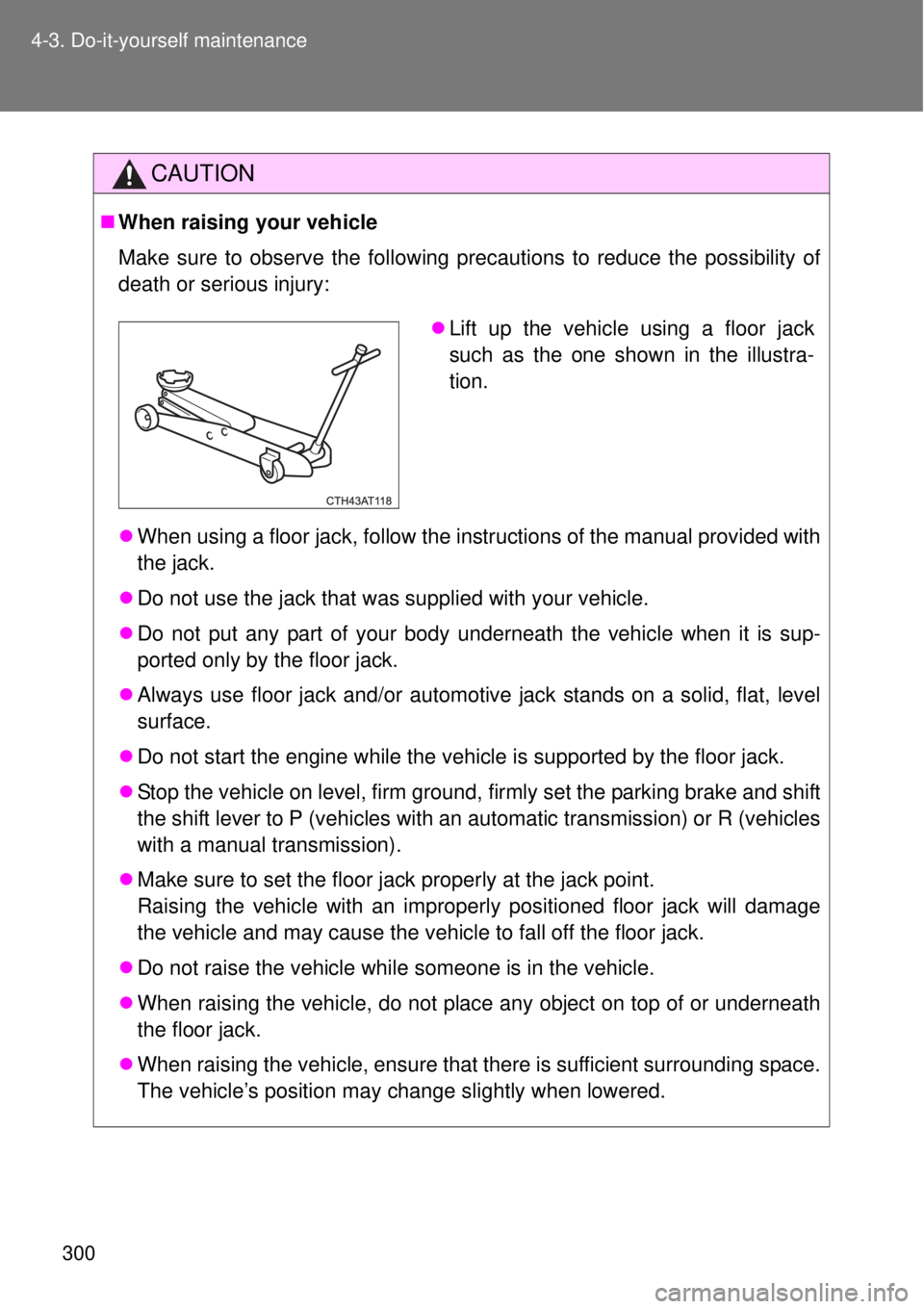
300 4-3. Do-it-yourself maintenance
CAUTION
When raising your vehicle
Make sure to observe the following precautions to reduce the possibility of
death or serious injury:
When using a floor jack, follow the instructions of the manual provided with
the jack.
Do not use the jack that was supplied with your vehicle.
Do not put any part of your body underneath the vehicle when it is sup-
ported only by the floor jack.
Always use floor jack and/or automotive jack stands on a solid, flat, level
surface.
Do not start the engine while the vehicle is supported by the floor jack.
Stop the vehicle on level, firm ground, firmly set the parking brake and shift
the shift lever to P (vehicles with an automatic transmission) or R (vehicles
with a manual transmission).
Make sure to set the floor jack properly at the jack point.
Raising the vehicle with an improperly positioned floor jack will damage
the vehicle and may cause the vehicle to fall off the floor jack.
Do not raise the vehicle while someone is in the vehicle.
When raising the vehicle, do not place any object on top of or underneath
the floor jack.
When raising the vehicle, ensure that there is sufficient surrounding space.
The vehicle’s position may change slightly when lowered.
Lift up the vehicle using a floor jack
such as the one shown in the illustra-
tion.
Page 381 of 464
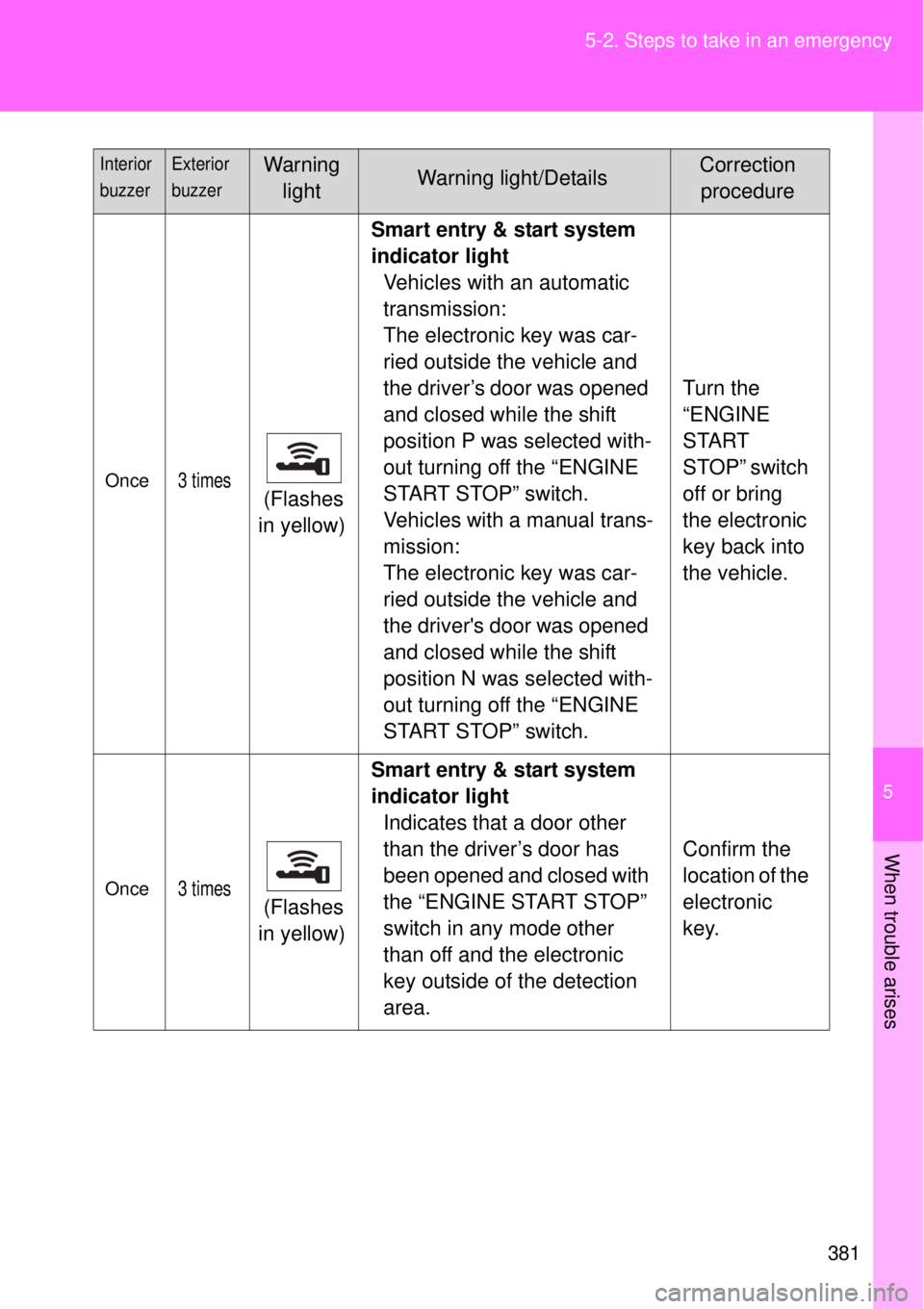
5
381 5-2. Steps to take in an emergency
When trouble arises
Once3 times (Flashes
in yellow)Smart entry & start system
indicator light
Vehicles with an automatic
transmission:
The electronic key was car-
ried outside the vehicle and
the driver’s door was opened
and closed while the shift
position P was selected with-
out turning off the “ENGINE
START STOP” switch.
Vehicles with a manual trans-
mission:
The electronic key was car-
ried outside the vehicle and
the driver's door was opened
and closed while the shift
position N was selected with-
out turning off the “ENGINE
START STOP” switch.Turn the
“ENGINE
START
STOP” switch
off or bring
the electronic
key back into
the vehicle.
Once3 times (Flashes
in yellow)Smart entry & start system
indicator light
Indicates that a door other
than the driver’s door has
been opened and closed with
the “ENGINE START STOP”
switch in any mode other
than off and the electronic
key outside of the detection
area.Confirm the
location of the
electronic
key.
Interior
buzzerExterior
buzzerWarning
lightWarning light/DetailsCorrection
procedure